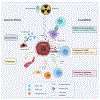Considerations when treating high-grade pediatric glioma patients with immunotherapy
- PMID: 33225764
- PMCID: PMC7880880
- DOI: 10.1080/14737175.2020.1855144
Considerations when treating high-grade pediatric glioma patients with immunotherapy
Abstract
Introduction: Children with high-grade gliomas (pHGGs) represent a clinical population in substantial need of new therapeutic options given the inefficacy and toxicity of current standard-of-care modalities. Although immunotherapy has emerged as a promising modality, it has yet to elicit a significant survival benefit for pHGG patients. While preclinical studies address a variety of underlying challenges, translational clinical trial design and management also need to reflect the most updated progress and lessons from the field.
Areas covered: The authors will focus our discussion on the design of clinical trials, the management of potential toxicities, immune monitoring, and novel biomarkers. Clinical trial design should integrate appropriate patient populations, novel, and preclinically optimized trial design, and logical treatment combinations, particularly those which synergize with standard of care modalities. However, there are caveats due to the nature of immunotherapy trials, such as patient selection bias, evidenced by the frequent exclusion of patients on high-dose corticosteroids. Robust immune-modulating effects of modern immunotherapy can have toxicities. As such, it is important to understand and manage these, especially in pHGG patients.
Expert opinion: Adequate integration of these considerations should allow us to effectively gain insights on biological activity, safety, and biomarkers associated with benefits for patients.
Keywords: Biological correlates; clinical trial design; diffuse intrinsic pontine glioma; diffuse midline glioma; high-grade glioma; immunotherapy; toxicity.
Conflict of interest statement
Declaration of interests
H Okada declares consultant fees from Bristol-Myers Squibb as well as royalties as inventor of: the H3.3K27M TCR, IL-13Ra2 (345–353:1A9V) peptide, and EGFRvIII-CAR for which an exclusive licensing agreement has been executed with Tmunity, Inc., Stemline, Inc. and Novartis Pharma, respectively. The authors have no other relevant affiliations or financial involvement with any organization or entity with a financial interest in or conflict with the subject matter or materials discussed in this manuscript apart from those disclosed.
Figures

References
-
- Crotty EE, Leary SES, Geyer JR et al. Children with DIPG and high-grade glioma treated with temozolomide, irinotecan, and bevacizumab: the Seattle Children’s Hospital experience J Neurooncol, 148, 607–17 (2020) - PubMed
Publication types
MeSH terms
Grants and funding
LinkOut - more resources
Full Text Sources
Medical
Research Materials
